Do you often look at your Preset palette in the Develop Module and find yourself overwhelmed with the possibilities, often in staggering disarray, making it hard to find what you are looking for? An overabundance of options can sometimes stifle creativity, and having a bunch of presets designed for graphic art does not aid you when editing a wedding.
Adobe could help solve this organizational nightmare with the addition of nested folders in the Presets palette, however, that is not available in Lightroom 2 and has not appeared in the Lightroom 3 beta. If you could have separate folders containing all the presets you need for a specific task, well organized, it would make the editing phase of any workflow easier and quicker.
There is a workaround for keeping unique sets of presets well organized and at your disposal, but we have to step out of the friendly confines of Lightroom and into the wild of the host operating system. By directly changing the contents of the Lightroom Develop Presets folder, you can change your preset collection quickly and easily before starting Lightroom. Let us take a look at how this can be accomplished.
This will be broken down inside of Windows 7, however prior versions of Windows and Mac OS will work quite similarly. First navigate your explorer or finder to your Lightroom Presets Folder. The proper path for your OS is listed below.
Mac OSX – /Users/UserName/Library/Application Support/Adobe/CameraRawFolder/Settings
Windows XP – C:Documents and SettingsUserNameApplication DataAdobeCameraRawSettings
Vista & 7 – C:UsersUserNameAppDataRoamingAdobeCameraRawSettings
Simply insert your user name into the UserName field. On Windows Vista and 7, hidden folders may be enabled on your system, preventing you from seeing the AppData folder. Fixing this issue is a bit more than I want to get into here, but a quick look here should give you the knowledge to handle the situation quickly.
By directly changing the contents of the Lightroom Develop Presets folder, you can change your preset collection quickly
With that aside, we can move on. Once in the Settings folder, you should see a series of folders that Lightroom uses to contain presets, templates and web engines. Select and enter the Develop Presets folder.
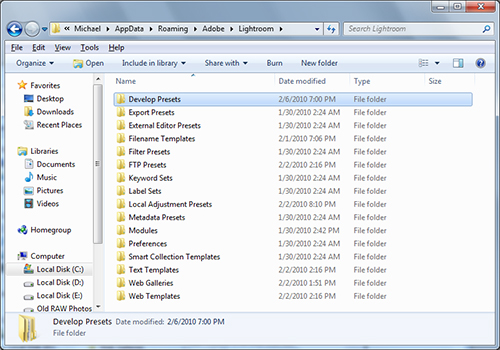
Once inside, you should see a series of folders that name the different groupings of presets present in your Presets palette in the Develop Module.
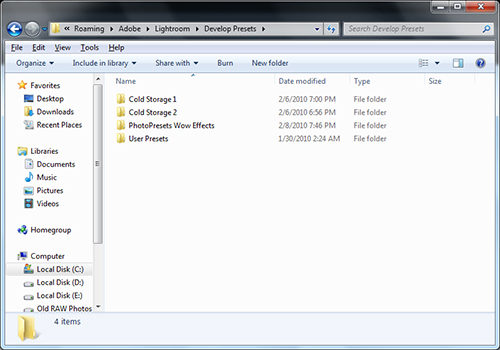
So, before we go further we need to back up these presets that compose your master preset collection. Simply select all the folders and copy them.
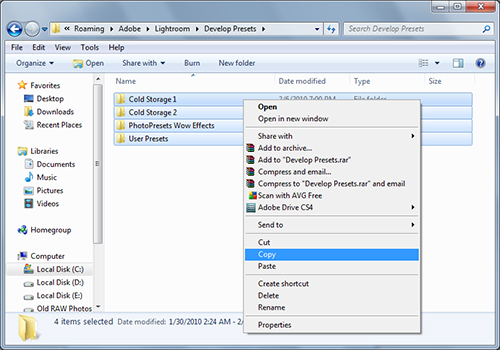
Now, navigate back to the Settings folder and create a new folder entitled Presets Library.
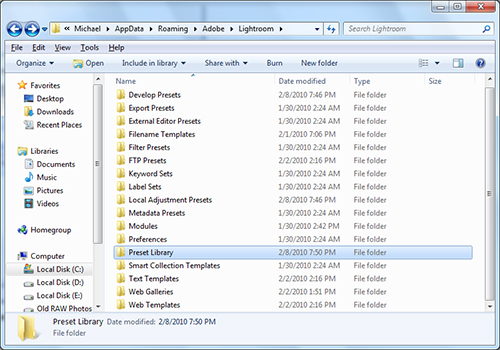
Inside that new folder create another folder entitled Master Library.
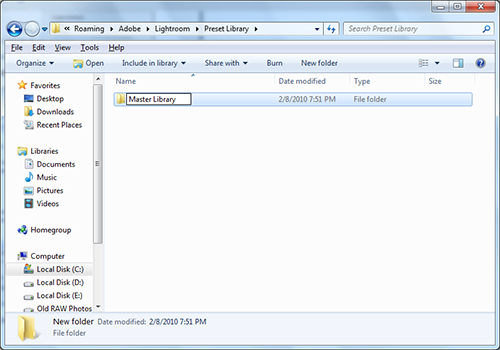
Now paste those folders you copied earlier into this folder. Now you have a reference copy of your preset collection.
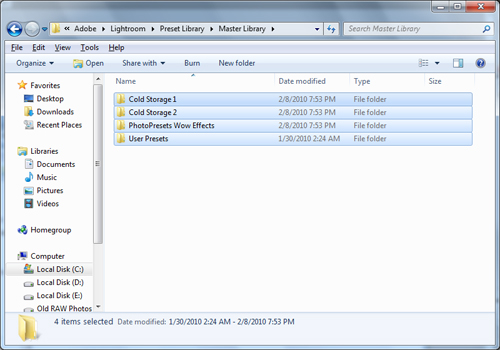
Back in Lightroom decide on a theme for your new preset collection. Assume you want to create a custom collection just for weddings. Obviously you probably will not need any presets that produce extreme effects, like a pseudo-HDR preset. So start removing the presets you feel you will never or rarely use whilst editing weddings.
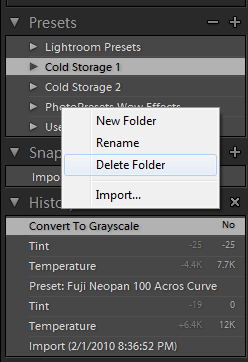
This removes the pearls from the oysters, leaving you only the presets that will help you in your endeavor, removing those that would merely distract. It also will help tame the beast that many of our Preset palettes have become. Go ahead and close Lightroom for now.
Back in your OS file manager, navigate back to the Develop Presets folder inside the Settings folder. Again, select and copy the entirety of the folders present inside the Develop Presets folder.
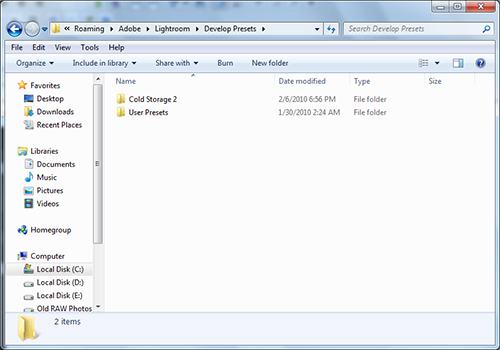
Now navigate back to the Settings folder and open your Presets Library folder. Create a new folder entitled Wedding Library, open it and paste the folders you just copied into it.
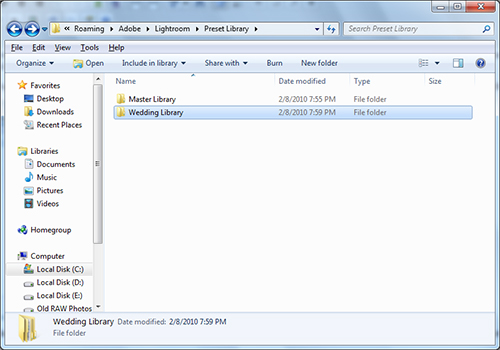
You now have two libraries of presets, your Master and Wedding libraries.
If you open Lightroom at this time, it will still contain your Wedding Library, but we have more libraries to make. So now you need to navigate back to Settings >> Develop Presets and select all once again. This time, simply delete all the files present, as you have already copied them.
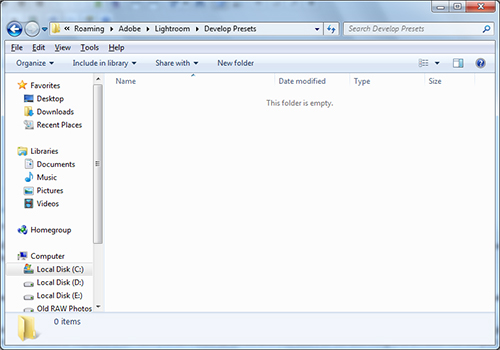
Now head back over to Settings >> Presets Library >> Master Library. Select all of the contents and copy. Now return to Settings >> Develop Presets and paste those files back.
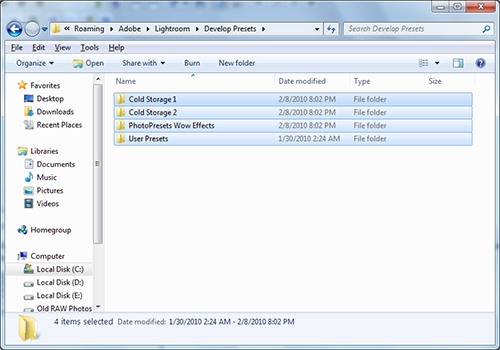
You have restored your Master Library.
Open up Lightroom now, and start parsing down for your next specialized library. Follow the directions above for as many libraries as you wish to create. Make sure to give their folders in the Presets Library folder descriptive names, so you can remember what each is for. Once you have made all the libraries you desire for the time being, you are done with this part.
Now, when you start a new session from a fresh upload, you can consider which library of presets you desire. Say you just imported a series of nature landscapes you did on vacation. You currently have your Portrait Library of presets in Lightroom, but you want you Outdoors Library for these images. First close out Lightroom. Then, in your OS file manager, navigate to the Lightroom Settings folder.
From there, open the Develop Presets folder, select all and delete. Then navigate back to Settings >> Preset Library and then open your Outdoors Library you had made. Select all and copy, then return to the Settings >> Develop Presets folder and paste your Outdoors Library.
Now, reopen Lightroom an you will find that your Outdoor Library is now the contents of the Presets palette. Switching fro one to the other is easy, but a bit time consuming. However it can save you time searching for the preset you need later on. Hopefully Adobe will one day add nested folders to the Presets palette, allowing you to simply have a high level folder containing all your presets for given tasks, opening up when needed and keeping the others collapsed. Until then, this method offers a meager solution to keeping your presets nice and tidy.
An added benefit of this system is that it make backing your presets up easy. Add this folder to your backup program, online backup or simply copy it off to a CD or USB key every once in a while. Then you don’t have to fear losing your presets, losing the time it took to perfect them or the time and money spent amassing them.
In fact, you really should consider adding all the contents of the Lightroom Settings folder to your backup regimen. This will protect all your presets and templates, not to mention web gallery engines you may have purchased. If you lose you system and have a backup of these folders, you can simply copy them back one you have re-installed or setup your new system. Then the next time you fire up Lightroom, everything will be right with the world.
If you store you presets with your Catalogs, some of this may not be applicable. However, a majority of users keep presets as part of Lightroom’s settings, available to all catalogs, and this system may be of great use. You will find that if you implement this structure on your own machine, you will be more organized, have the right tools at the right time and backed up for a dreaded, but likely inevitable, disaster of some kind.


